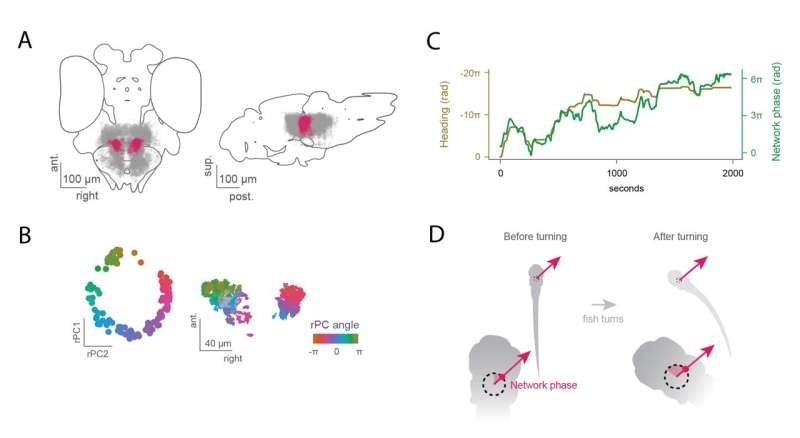Zebrafish Travel Direction Represented by Neuronal Network

May 30, 2023 feature
This article has been reviewed according to Science X's editorial process and policies. Editors have highlighted the following attributes while ensuring the content's credibility:
- fact-checked
- peer-reviewed publication
- trusted source
- proofread
by Ingrid Fadelli, Medical Xpress
Past studies have found that the brains of some animals generate representations of the direction in which they are headed. For instance, the heading direction of insects is represented by the activity of neurons in a region at the center of their brain, known as the central complex.
Researchers at Technical University of Munich recently carried out a study aimed at identifying similar neural networks that represent the traveling direction of zebrafish, while also unveiling their underlying dynamics. Their findings, published in Nature Neuroscience, pinpoint a specific network in the anterior hindbrain of zebrafish that appears to represent the direction in which they are headed.
'Previous work in my lab revealed a region that is involved in decision making, in particular the decision of turning left or right,' Ruben Portugues, one of the researchers who carried out the study, told Medical Xpress.
'This region, the interpeduncular nucleus, is a circular structure that can be found in the middle of the vertebrate brain. The anatomy and dynamics of this brain structure reminded us of a deep circular structure of the insect brain, the ellipsoid body, which is important for navigation and was shown to represent the insect heading direction.'
This recent study draws inspiration from previous works carried out by other research teams, such as Vivek Jayaraman's lab at the Howard Hughes Medical Institute in Virginia and Gaby Maimon's lab at the Rockefeller University. These works identified a brain region that appears to represent the heading direction of insects.
In their experiments, Portugues and his colleagues thus specifically searched for heading direction representations in zebrafish neurons that projected to this brain region.
'Heading direction neurons were found in rodents in the '90s, yet the full network was never observed and we lacked understanding of how the heading representation is generated,' Portugues explained. 'Our main goal in this study was to find the zebrafish heading direction network and image a large part of the network simultaneously. This allowed us to characterize the network and how it represents the animal's heading direction.'
In their experiments, Portugues and his colleagues examined neurons in the zebrafish hindbrain using functional imaging techniques. More specifically, they collected images using a microscope they built, dubbed Light sheet microscope, which can image the activity of several neurons simultaneously.
'We also reconstructed the morphology of neurons in this region from an already existing electron microscopy dataset,' Portugues said. 'From this dataset it was possible to detect where these neurons send their projections and how they are connected to other neurons in the network. Our reconstructions revealed that heading direction neurons inhibit the heading neurons that represent the opposite heading direction. This ensures that only a single heading direction is represented at any given time point.'
Since neuroscientists first discovered the existence of so-called 'heading direction neurons' several decades ago, many theoretical models have been introduced to explain how these neurons are connected in a network. The studies in insects had shown beautiful agreement between theory and experiments but very little could be said about the heading direction networks in vertebrates (i.e., animals that possess a backbone or spinal column).
Portugues and his colleagues are the first to collect findings confirming that heading direction neural circuits also exist in the brain of zebrafish.
'Our recent work shows the existence of such networks in a vertebrate brain,' Portugues said. 'Thanks to the zebrafish transparency and small size, we could reveal the architecture of the network, granting us a mechanistic understanding of how it works. In addition, while insects and vertebrates have very different brains, we show that heading direction systems in both share many connectivity patterns, suggesting that some architectural principles of neural systems are preserved across the animal kingdom.'
The recent findings gathered by this team of researchers could soon pave the way for studies looking for neural representations of heading direction in the brain of other vertebrates, such as different fish species, birds, amphibians, reptiles or even mammals. Collectively, these works could shed some interesting new light on how animals' decisions regarding where to travel are stored or represented in their brain.
'In our recent study, we discovered a network that encodes the heading direction signal,' Portugues added.
'We now plan to discover how this signal is generated, where this signal is transmitted to in the brain and how fish are using it to navigate the environment. Specifically, we would like to investigate what happens when the animal navigates towards a goal; how it is using the heading signal and what happens when this signal is impaired.'
© 2023 Science X Network




